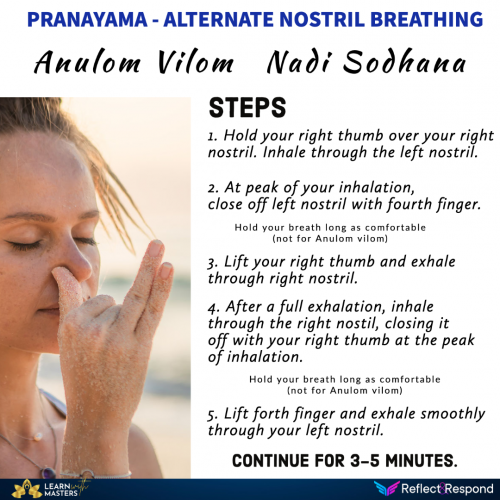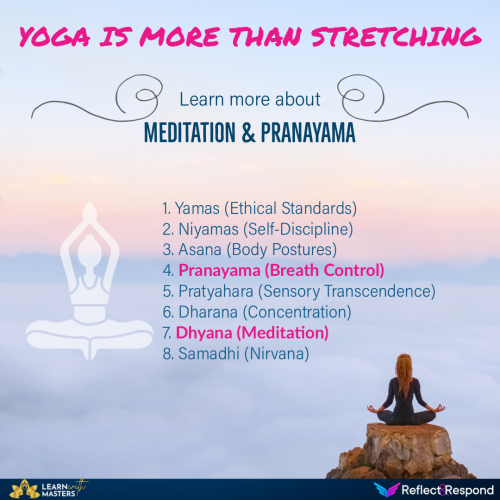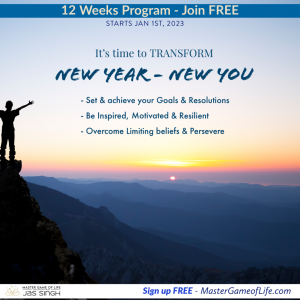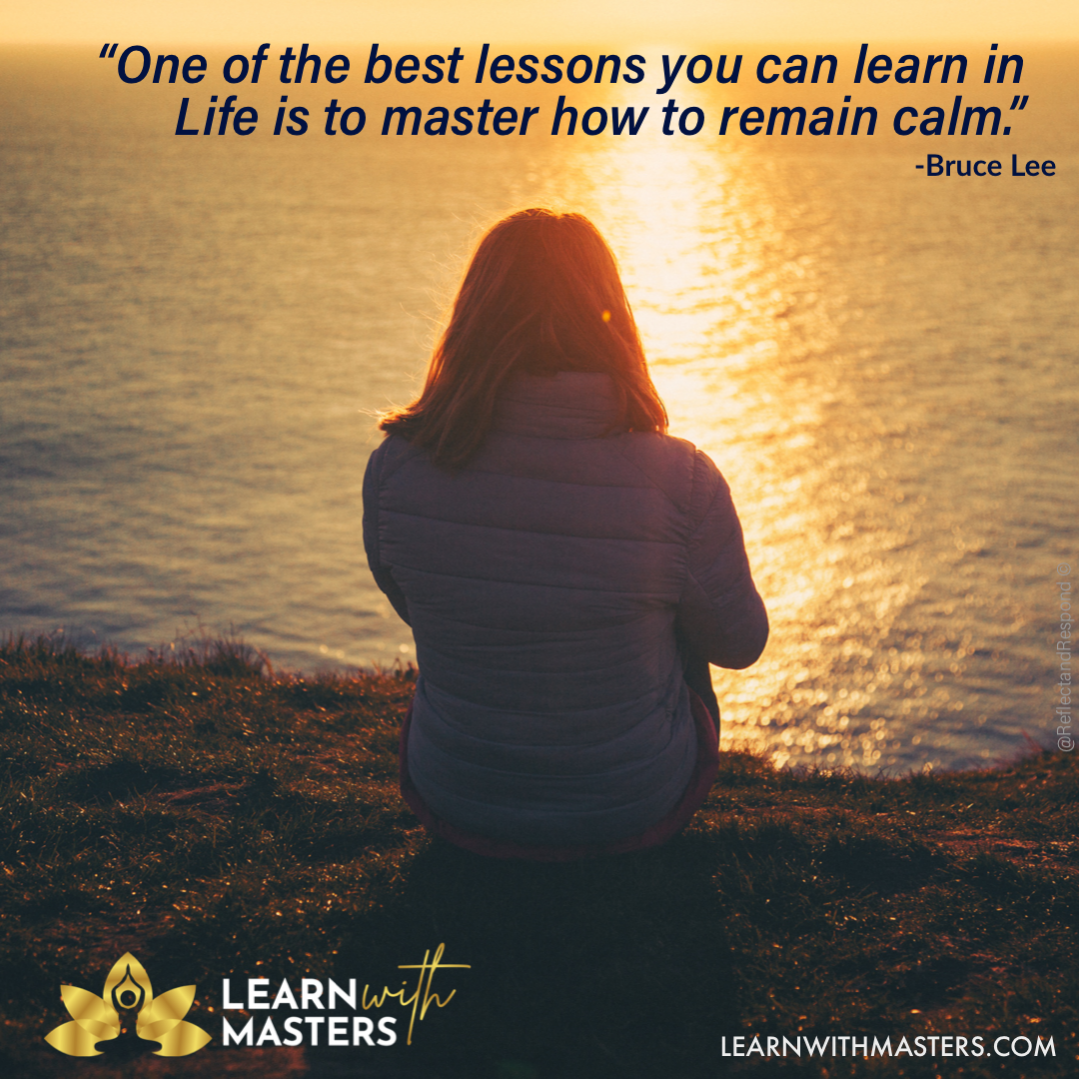First the question, what is pranayama?
Pranayama \praa-nuh-yaa-muh\
Pranayama can be defined as the action of expanding the life-force energy in our bodies through intentional breathing.
Breath is the carrier of Prana—the primordial life force. Pranayamas are breathing techniques by which Prana can be regulated and channeled. These breathing exercises can calm, balance, cleanse, or invigorate the mind and body to enhance overall well-being.
Pranayama can help:
- reduce anxiety and depression
- lower and stabilize blood pressure
- increase energy levels
- improve immunity
- decrease feelings of anxiety & over whelming
Breathe to Improve Your Physical and Emotional Health
Now, many people ask that…what is the need for pranayama?
Our goal is to just lose weight, or gain strength, or be more flexible. Then, why is this breathing exercise so important!?
According to a 2017 medical research, those who practice pranayama had higher levels of self awareness than those who didn’t. Additionally, emotional regulation improved in the same students. This was linked to pranayama’s soothing impact, which helps ones ability to be more mindful.
Pranayama was also found to reduce perceived stress levels in healthy young adults in a 2013 study. According to the experts, pranayama relaxes the neurologic system, enhancing the stress response. Lastly, it has been observed in a medical study on young adults that regular pranayama practice for more than 8 to 12 weeks can help significant decrease in Body Mass Index (BMI), which can help control weight.
Prana is considered the source of all bodily activity. It controls all biological functions, both conscious and unconscious, including breathing, digestion, blood flow, elimination, cellular growth and healing.
The quality and quantity of the Nadis energy conduits and the chakras energy centers determine how Prana distributes its energy throughout the body.
Prana animates our ideas, emotions, and consciousness. Thus, the amount of circulation of Prana in our bodies is closely related to our physical, emotional, and mental health.
Therefore, no matter what body goals you desire to achieve, making pranayama an integral part of your yogic practice will assist you in reaping the maximum benefits.
3 Must-Try Pranayama Techniques for Everyone
Below-listed are three essential pranayama techniques with their steps and effects, that everyone must perform daily to enhance overall physical, emotional, and mental wellbeing. The best time to practice is early morning and on an empty stomach.
1. Nadi Shodhana (Alternate Nostril Breathing)
It’s a yogic breath control technique that literally means “subtle energy cleansing breathing technique.” Breathwork like this can be done as part of a yoga asana practice or meditation session.
Alternate nostril breathing can also be practiced on its own to help you calm and rest your mind. If you are a beginner, it would be helpful to have a yoga teacher demonstrate the technique in person so that you can ensure you’re doing it correctly.
There is another technique that is very similar to the above called Anulom Vilom.
What is the Difference between Nadi Sodhan and Anulom Vilom Pranayama?
In Anulom Vilom, there is no need to hold the breath, whereas, in Nadi Sodhan, one needs to hold the breath inside for as long as possible.
For example start the practice of 2-second Inhale, 5-second retention, and 8-second exhalation.
In Anulom Vilom air is inhaled from the left nostril and exhaled from the right one, after that it is inhaled from the right nostril and exhaled from the left one. (without the hold)
Both Nostrils are connected to the anti-directional area of the Brain. When you Inhale from the left, you try to supply energy to awaken the right side of the mind. and when you take a breath (Prana) from the right nostril, you try to awaken the left side of the Brain.
To perform alternating nostril breathing, do the following:
The first step is to take a proper position.
Sitting with a straight spine.
- Place the right thumb on the right nostril.
Inhale through the left nostril. - At the peak of your inhalation, close off the left nostril with the fourth finger.
- Lift your right thumb and exhale through the right nostril.
- After a full exhalation, inhale through the right nostril, closing it off with your right thumb at the peak of inhalation.
- Lift forth finger and exhale smoothly through your left nostril.
CONTINUE FOR 3-5 MINUTES.
2. Ujjayi (Victorious Breath):
This breathing exercise produces a sound similar to that of ocean waves, which has a cooling effect. It is most commonly utilized to support yoga postures, particularly in vinyasa yoga. The back of the throat is constricted to assist in the lengthening of each breath cycle in this breathing method. Long, complete, deep, and controlled inhalations and exhalations are used for this practice. To perform victorious breathing, do the following:- Sit cross-legged.
- Take a deep breath in through your mouth and constricted throat, generating a hissing sound as you do so.
- Without speaking (without voice?), slowly exhale through your nostrils, keeping your throat tight.
- Repeat the cycle until you can do it with no effort.
3. Coherence Breathing:
Simply breathe in and out in a ratio with out longer than in breath.
This form of controlled breathing is occasionally used as part of yogic meditation rituals. Inhale through the nose and exhale thru the nose.
To perform coherence breathing, do the following:
- Pay attention to your natural breaths to establish a baseline.
- Count the length of each inhalation and exhale.
- Get into a comfortable position to practice breathing in a synchronized manner.
- Take a four-second inhale thru the nose and a five or six seconds exhale thru the nose
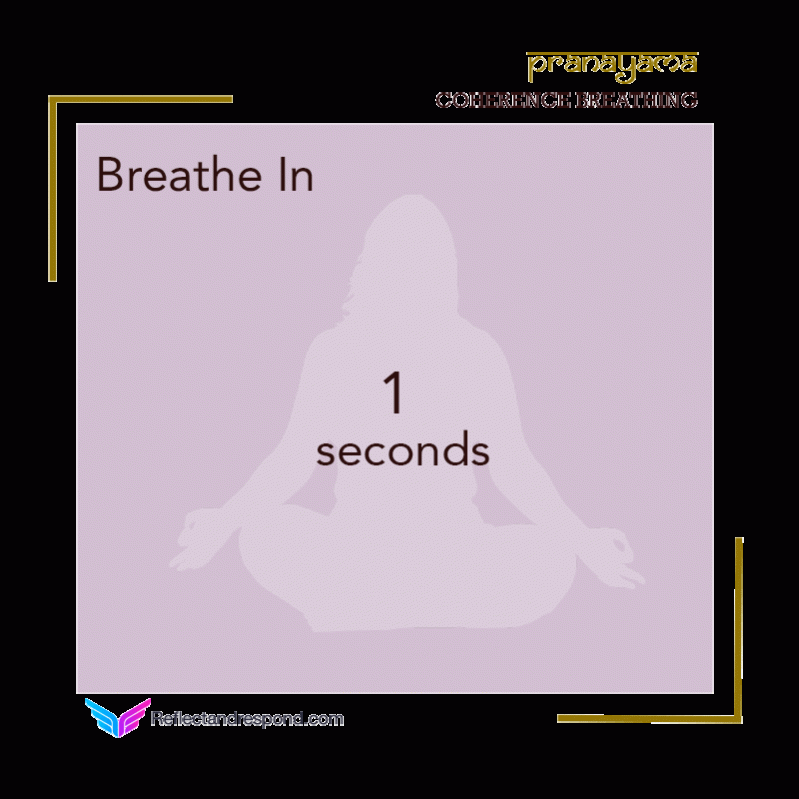
Tips:
- You can try to place one hand on your belly and the other hand on your back or heart.
- You can start by breathing out of your mouth to get the feeling and then close your mouth and internally make the sound as you breathe out.
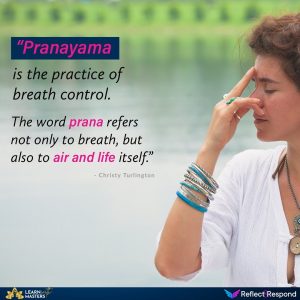
“Pranayama is the practice of breath control.The prana refers not only to breath but also to air and life itself.”
Christy Turlington
“Pranayama teaches the aspirant to regulate his breathing and thereby control the mind.”
B.K.S. Iyengar
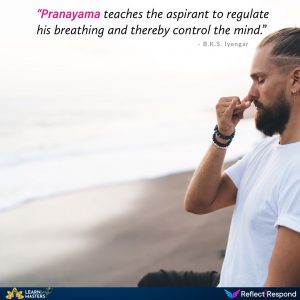
Hatha yoga & pranayama can be used to balance each of the three doshas.
Balancing Vata – Utilize Coherence breathing
The body often responds to stress by holding in the breath (or breathing too quickly). This breathing technique extends the length of the inhalations and exhalations—making them longer and deeper to relax the body and bring a sense of relief.
Balancing Pitta – Utilize Ujjayi victorious breath
(simultaneously relaxing and energizing the mind & body)
Balancing Kapha – Utilize bhastrika breathing
Instead of Coffee, start your day with bhastrika, the bellows breath to get you going.
The Final Note
If you have not tried pranayama before, you can take a yoga class that gives emphasis to breathing. Also look for a teacher who can show you how to accomplish these breathing techniques properly.
Practicing any one of the above-mentioned breathing techniques will help you reap benefits such as relief from stress and anxiety, purification and balancing of the Nadis as well as enhanced blood circulatory and respiratory function.
For those who practice yoga, breathing techniques like Pranayama are an important key to healthy living!
Breathing is life! Throughout our life, we will take around half a billion breaths without even realizing it. More often we breathe shallow and Pranyamas remind us to breathe deeper. Combined with Yoga we can expand our lungs as we breathe in and let go, release as we breathe out.
Pranayama techniques help me to enhance and bring about even greater balance and well-being.
My favorite is coherence breathing as it helps in releasing stress, anxiety. It gives my body and brain a signal to take a pause, breathe deeper and every thing is ok.
“Master your breath, let the Self be in Bliss, contemplate on the sublime within you.”
– Tirumalai Krishnamacharya
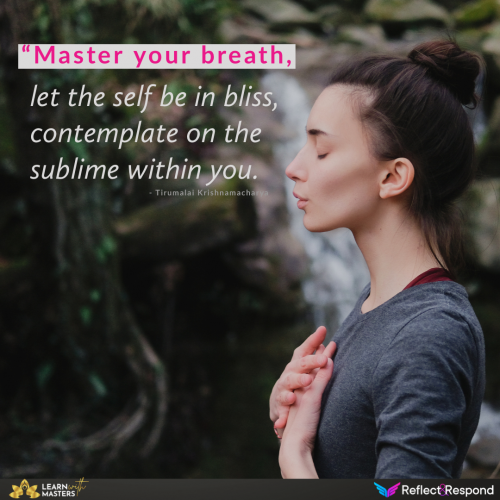
Understanding pranayama breathing during my training as a yoga teacher, I have learned to focus on ujjayi breathing to go deeper into asanas. Many asanas need focusing on breath to reach the maximum benefit by focusing on our asanas. When I go into my deepest asana, I have been able to release some of the buried old emotions from childhood. Inhaling thru my nose to get deeper into ujjayi breath till my throat makes the noise and I si out exhale from my mouth and push myself deeper into asana to find the comfort of release.
Starting my morning with Surya Namaskar with pranayama breath allows my mind to be relaxed, prepares me to start flowing thru the day and reminds me to keep breathing throughout the day’s challenges by going back to being mindful of breath and focus on ujjayi.
During the hustle and bustle of daily life when I listen to people and I simultaneously place focus on my breath to bring more awareness. This allows me to be present, listen and give 100% attention to what the person is saying. By blocking all the other noise around me I am just listening to my breath and the other person’s voice.
I have learned that this tool of breath works. Breathing deeply through my nostrils, I hold my breath and listen to nurture sounds until I cannot hold my breath any more. I then release it out slowly like a vessel and it instantly calms my mind and my face starts looking relaxed.
To end my day, I sit on my bed and start pranayama breathing and every breath is focused on my seven chakras. I start with imagining my crown chakra and take an inhalation breath through my nostrils and releasing the breath through my mouth.I then move to my third eye, inhale and so forth until I reach my root chakra. I lay down instantly and fall into deep sleep as soon as my head is rested on my pillow
Since I have gained awareness of pranayama breathing, I have not had any anxiety attacks, asthma or fear. I have not used the inhaler since 2007. 🙏🏻







